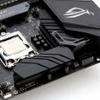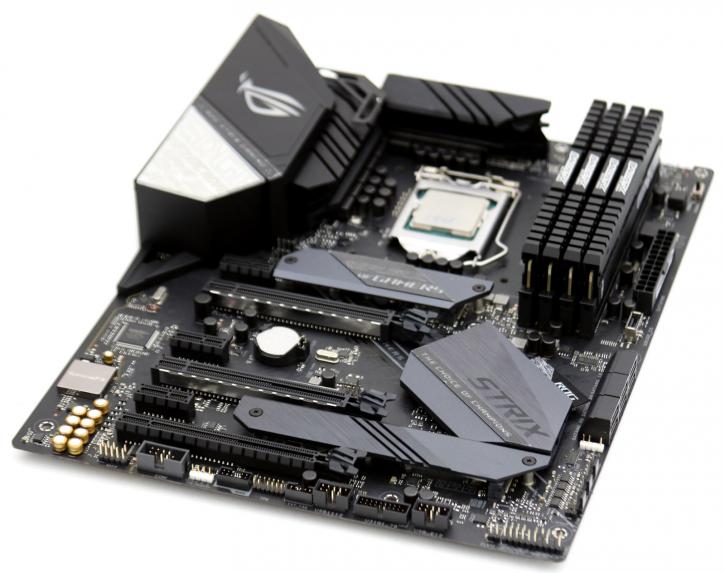Final Words & Conclusion
Conclusion
Hmm, you know what? I like the STRIX quite a lot, it's a stable platform, feature rich and has got proper WIFI. Somehow though the looks, while okay, are a bit lackluster? I mean compare it to the HERO review you've probably just read. Perf wise it is all mostly the same. You may expect all Z370 boards and brands perform toughly within the same 2% margin of error with an exception here and there. Overclocking wise we reached a stable 5.2 GHz, and that is for all eight cores. We stated it in other reviews, you'll likely see some processors hit 5.3 and others 5.0, but it is along these ranges. The platform (Z390/Coffee Lake) also manages heat and power consumption at okay levels. Overclocked, however, you will pass 80 Degrees C under load and that was with the proc under water (proverbially speaking).
Power consumption
With this eight cores and sixteen threads proc you get a 95 Watt TDP processor. With the system at idle with a GeForce RTX 2080 Ti installed / 16 GB memory / SSD and the Z390 motherboard, I hovered at roughly 60~65 Watts in IDLE. That's okay, the load values are okay as well but definitely higher. When we stressed the processor 100% run we reach roughly 200 Watts with this 8-core part. That's the entire system. That is on the high side alright. Then again, does anyone actually care about it when you get performance metrics like shown today?
DDR4 Memory
For Coffee Lake-S (8th and 9th Gen Intel procs) and DDR4 we always say, volume matters more than frequency. A 3,200 MHz kit, for example, is more expensive and does offer better bandwidth but the performance increase in real-world usage will be hard to find. Unless you transcode videos over the processor a lot. As always, my advice would be to go with lower clocked DDR4 memory with decent timings, but get more of it. Don't go for 8 GB, get two or four DIMMs and in total a minimum of 16 GB. The reason we test at 3200 MHz is simple, we do the same for AMD Ryzen and want to create a fair and equal playing ground for both. 3200 MHz is, however, a very nice equilibrium for both processor brands.
Performance & tweaking
We tested multiple Z390 motherboards all with the latest BIOS. Once tweaked we noticed that the eight cores like a bit of extra voltage, we expect all-core tweaks in the 5.1~5.2 GHz marker to need ~1.35 Volts on the processor. While that does increase power consumption, it wasn't something that scared me away. Some platforms will and procs will also be able to manage a lower voltage. If you plan a tweak at that 5.2 GHz marker then remember my remarks on cooling, you will need LCS, that or a very good heatpipe cooler. Again, we have been using an ES sample so I cannot say anything conclusive on the final retail products (these might run a tiny bit cooler). The infrastructure that Z390 offers is easy to use, you increase the CPU voltage and multiplier and you are good to go. Another plus for the Intel platform is that over the years they have been able to refine their memory controllers, pop in anything XMP 2.0 and you have a 90% chance it'll work straight out of the box with very fast memories. Mind you that all our tests are performed at 3200 MHz DDR4, similar to Ryzen and Threadripper to remain objective and for fair play on both sides. realistically though, Ryzen is more memory frequency dependent in gaming than Intel is.
Final words
ASUS initially segmented the STRIX towards a more entry-level segment for their motherboards, then a year later it was mainstream to high-end, and right now we feel is targeted in that mainstream towards high-end segment. It's a good board, but could look better? ASUS, however, sticks to a fairly simplistic feature-set (they use what the Intel chipset offers and not a lot more). We like new VRM design and heatsinks that go along with it, thermals show nothing out of the ordinary. A bit of a miss is that ASUS stuck towards 1 Gbps Ethernet. Realtek now has 2.5 Gbps available and Aquantia 10 Gbps Ethernet. Great, and I do mean really great is the new 2x2 AC WIFI implementation, the 5 GHz band is really strong. Connectivity wise in terms of your PCIe slots for your graphics subsystem you are looking at a full x16 Gen 3 lanes for one graphics cards. The second and PCIe slot shares its lanes with the first one, ergo you'd end up at a configuration like x8/x8. The third x16 slot, in fact, is an x4 slot which draws its lanes from the chipset. We expect Coffee lake to be able to manage the 5 GHz domain on all cores with exceptions running up towards 5.2 GHz (all-core). I base this metric on high-perf air coolers or decent enough liquid cooling. From there onwards you are looking at proc ASIC quality and cooling being the more important denominator. Interestingly, if you look at the OC page, look at the BIOS screenshot and it will readout ASIC quality, our CPU was at 94. I like stuff like that being readable in the BIOS. In the end, we can be short about this STRIX, it's really good when it comes to BIOS, features, and stability. The board performance and defaults also are good, was stable and has decent (but not exceptional) looks (if you like the style of course). We expect this board to sit in the sub 225 USD/EUR price marker. Recommended by Guru3D.com
Handy related downloads:
- Sign up to receive a notice when we publish a new article
- Or go back to Guru3D's front page



